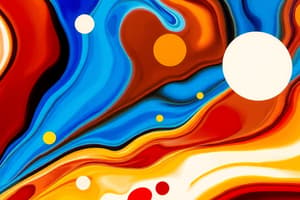Podcast
Questions and Answers
Glass is a non-crystalline, amorphous solid that is often ______ but can also be translucent or opaque.
Glass is a non-crystalline, amorphous solid that is often ______ but can also be translucent or opaque.
transparent
Fused Silica Glass is composed almost entirely of ______ dioxide (SiO2).
Fused Silica Glass is composed almost entirely of ______ dioxide (SiO2).
silicon
Soda-lime glass is the most common type of glass and is used to make ______, bottles, and containers.
Soda-lime glass is the most common type of glass and is used to make ______, bottles, and containers.
windows
Borosilicate glass has high resistance to ______, making it suitable for laboratory glassware.
Borosilicate glass has high resistance to ______, making it suitable for laboratory glassware.
Broken glass can be sharp and ______, so it should be handled with care.
Broken glass can be sharp and ______, so it should be handled with care.
Ceramics are formed by shaping and then firing a mixture of materials at high ______.
Ceramics are formed by shaping and then firing a mixture of materials at high ______.
The shaped object is dried to remove excess ______.
The shaped object is dried to remove excess ______.
Traditional ceramics are primarily composed of aluminosilicates, which include aluminum oxide and ______.
Traditional ceramics are primarily composed of aluminosilicates, which include aluminum oxide and ______.
Advanced ceramics like Alumina are known for their high ______ and wear resistance.
Advanced ceramics like Alumina are known for their high ______ and wear resistance.
Some ceramics require significant energy to produce, while others are made from abundant natural materials like ______.
Some ceramics require significant energy to produce, while others are made from abundant natural materials like ______.
Glass is typically hard and ______.
Glass is typically hard and ______.
The rapid cooling of a molten mixture prevents the atoms from forming a regular ______ structure.
The rapid cooling of a molten mixture prevents the atoms from forming a regular ______ structure.
Lead glass has a high ______ index, which causes it to sparkle brilliantly.
Lead glass has a high ______ index, which causes it to sparkle brilliantly.
Soda-lime glass has good chemical ______ and is easy to form and shape.
Soda-lime glass has good chemical ______ and is easy to form and shape.
Glass is recyclable, which helps reduce ______ and conserve resources.
Glass is recyclable, which helps reduce ______ and conserve resources.
The raw materials for ceramics include clay, feldspar, quartz, and other ______.
The raw materials for ceramics include clay, feldspar, quartz, and other ______.
The drying process removes excess ______ from the shaped object.
The drying process removes excess ______ from the shaped object.
Alumina, a type of advanced ceramic, is known for its high ______ and wear resistance.
Alumina, a type of advanced ceramic, is known for its high ______ and wear resistance.
Silicon Carbide (SiC) is recognized for its extreme ______ and high thermal conductivity.
Silicon Carbide (SiC) is recognized for its extreme ______ and high thermal conductivity.
Zirconia (ZrO2) has high toughness, high melting point, and is known for its chemical ______.
Zirconia (ZrO2) has high toughness, high melting point, and is known for its chemical ______.
Glass is typically hard and ______.
Glass is typically hard and ______.
Borosilicate glass is known for its high resistance to ______.
Borosilicate glass is known for its high resistance to ______.
Soda-lime glass is composed of silicon dioxide, sodium oxide, and ______ oxide.
Soda-lime glass is composed of silicon dioxide, sodium oxide, and ______ oxide.
Lead glass is distinguished by its high ______ index.
Lead glass is distinguished by its high ______ index.
Glass is generally ______, meaning it does not react readily with most substances.
Glass is generally ______, meaning it does not react readily with most substances.
The process of making ceramics involves preparation, shaping, drying, and ______.
The process of making ceramics involves preparation, shaping, drying, and ______.
Alumina is primarily used in ______ tools and biomedical implants due to its high hardness.
Alumina is primarily used in ______ tools and biomedical implants due to its high hardness.
Zirconia is known for its high toughness and is often used in ______ sensors and fuel cells.
Zirconia is known for its high toughness and is often used in ______ sensors and fuel cells.
Some advanced ceramics, like Silicon Carbide, are known for their extreme ______ and high thermal conductivity.
Some advanced ceramics, like Silicon Carbide, are known for their extreme ______ and high thermal conductivity.
Ceramics exhibit properties such as brittleness, high melting point, and ______ insulation.
Ceramics exhibit properties such as brittleness, high melting point, and ______ insulation.
Flashcards are hidden until you start studying
Study Notes
Glass: Definition and Formation
- Amorphous solid, often transparent but can be translucent or opaque.
- Typically hard and brittle.
- Formed by rapidly cooling molten inorganic materials, preventing crystalline structure.
Types of Glass
- Fused Silica Glass (SiO2): Almost pure silicon dioxide; high melting point, low thermal expansion, excellent transparency; used in lenses, prisms, optical fibers, and high-temperature applications.
- Soda-lime Glass (SiO2, Na2O, CaO): Silicon dioxide, sodium oxide, calcium oxide; relatively low melting point, good chemical durability; used in windows, bottles, and containers (most common type).
- Borosilicate Glass (SiO2, B2O3, Na2O, Al2O3): Silicon dioxide, boron oxide, sodium oxide, aluminum oxide; high thermal shock resistance, good chemical durability; used in laboratory glassware and cookware.
- Lead Glass (SiO2, PbO, K2O): Silicon dioxide, lead oxide, potassium oxide; high refractive index; used in crystal glassware and decorative items.
Glass: Properties and Environmental Impact
- Physical properties: Transparency, brittleness, hardness, non-crystalline structure.
- Chemical properties: Generally inert, resistant to most acids (except hydrofluoric acid).
- Recyclable, reducing waste and conserving resources.
- Safety hazard: Broken glass is sharp; handle with care.
Ceramics: Definition and Formation
- Inorganic, non-metallic solids; typically hard, brittle, and heat-resistant.
- Formed by shaping and firing a mixture of materials at high temperatures.
- Process involves preparing raw materials (clay, feldspar, quartz), shaping, drying, and firing.
Types of Ceramics
- Traditional Ceramics (Clay): Primarily aluminosilicates; used in bricks, pottery, and tiles.
- Advanced Ceramics:
- Alumina (Al2O3): High hardness, wear resistance, high melting point; used in cutting tools, spark plugs, and biomedical implants.
- Silicon Carbide (SiC): Extreme hardness, high thermal conductivity, low thermal expansion; used in cutting tools, abrasives, and high-temperature applications.
- Zirconia (ZrO2): High toughness, high melting point, chemical inertness; used in dental implants, oxygen sensors, and high-temperature applications.
Ceramics: Properties and Environmental Impact
- Properties: Hardness, brittleness, high melting point, chemical inertness, electrical insulation, low thermal conductivity (except some advanced ceramics).
- Wide range of applications in construction, engineering, electronics, medicine.
- Some made from abundant natural materials; others require significant energy. Recycling is increasingly important.
Glass: Definition and Formation
- Amorphous solid, often transparent but can be translucent or opaque.
- Typically hard and brittle.
- Formed by rapidly cooling molten inorganic materials, preventing crystalline structure formation.
Types of Glass
- Fused Silica Glass (SiO2): High melting point, low thermal expansion, excellent UV/visible light transparency. Used in lenses, prisms, optical fibers, and high-temperature applications.
- Soda-lime Glass (SiO2, Na2O, CaO): Most common type; relatively low melting point, good chemical durability, easily formed. Used in windows, bottles, jars, and containers.
- Borosilicate Glass (SiO2, B2O3, Na2O, Al2O3): High thermal shock resistance, good chemical durability. Used in laboratory glassware and cookware.
- Lead Glass (SiO2, PbO, K2O): High refractive index, sparkles brilliantly. Used in crystal glassware and decorative items.
Glass: Properties and Impact
- Physical properties: Transparency, brittleness, hardness, non-crystalline structure.
- Chemical properties: Generally inert, resistant to most acids (except hydrofluoric acid).
- Environmental impact: Recyclable, reducing waste and conserving resources.
- Safety concerns: Broken glass is sharp and dangerous.
Ceramics: Definition and Formation
- Inorganic, non-metallic solids; typically hard, brittle, and heat-resistant.
- Formed by shaping and firing a mixture of materials at high temperatures.
- Process involves preparing raw materials (clay, feldspar, quartz), shaping, drying, and firing.
Types of Ceramics
- Traditional Ceramics (Clay-based): Primarily aluminosilicates, with impurities. Used in bricks, pottery, and tiles.
- Advanced Ceramics:
- Alumina (Al2O3): High hardness, wear resistance, high melting point. Used in cutting tools, spark plugs, and biomedical implants.
- Silicon Carbide (SiC): Extreme hardness, high thermal conductivity, low thermal expansion. Used in cutting tools, abrasives, and high-temperature applications.
- Zirconia (ZrO2): High toughness, high melting point, chemical inertness. Used in dental implants, oxygen sensors, and high-temperature applications.
Ceramics: Properties and Impact
- Properties: Hardness, brittleness, high melting point, chemical inertness, electrical insulation, generally low thermal conductivity (except SiC).
- Applications: Wide range in construction, engineering, electronics, medicine, and daily life.
- Environmental impact: Some use abundant materials, others require significant energy; recycling is important.
Glass: Definition and Formation
- Amorphous solid, often transparent but can be translucent or opaque.
- Typically hard and brittle.
- Properties adaptable for various applications.
- Formed by rapidly cooling molten inorganic materials, preventing crystalline structure formation.
Types of Glass
- Fused Silica Glass (SiO2): Almost pure silicon dioxide; high melting point, low thermal expansion, excellent UV and visible light transparency; used in lenses, prisms, optical fibers, and high-temperature applications.
- Soda-lime Glass (SiO2, Na2O, CaO): Silicon dioxide, sodium oxide, calcium oxide; relatively low melting point, good chemical durability, easy to form; used in windows, bottles, jars, and light bulbs (most common type).
- Borosilicate Glass (SiO2, B2O3, Na2O, Al2O3): Silicon dioxide, boron oxide, sodium oxide, aluminum oxide; high thermal shock resistance, good chemical durability; used in laboratory glassware, cookware, and heat-resistant applications.
- Lead Glass (SiO2, PbO, K2O): Silicon dioxide, lead oxide, potassium oxide; high refractive index, brilliant sparkle; used in crystal glassware and decorative items.
Glass: Properties and Environmental Impact
- Physical properties: Transparency, brittleness, hardness, non-crystalline structure.
- Chemical properties: Generally inert, resistant to most acids (except hydrofluoric acid).
- Recyclable, reducing waste and conserving resources.
- Safety precaution: Handle broken glass with care due to sharpness.
Ceramics: Definition and Formation
- Inorganic, non-metallic solids; typically hard, brittle, and heat-resistant.
- Formed by shaping and firing a high-temperature mixture of materials.
- Formation process involves raw material preparation, shaping, drying, and high-temperature firing in a kiln.
Types of Ceramics
- Traditional Ceramics (Clay): Primarily aluminosilicates with impurities; used in bricks, pottery, and tiles.
- Advanced Ceramics:
- Alumina (Al2O3): High hardness, wear resistance, high melting point; used in cutting tools, spark plugs, abrasives, and biomedical implants.
- Silicon Carbide (SiC): Extreme hardness, high thermal conductivity, low thermal expansion; used in cutting tools, abrasives, high-temperature applications, and brake discs.
- Zirconia (ZrO2): High toughness, high melting point, chemical inertness; used in dental implants, oxygen sensors, high-temperature applications, and fuel cells.
Ceramics: Properties and Environmental Impact
- Properties: Hardness, brittleness, high melting points, chemical inertness, electrical insulation, generally low thermal conductivity (except SiC).
- Applications: Wide range in construction, engineering, electronics, medicine, and everyday life.
- Environmental impact: Some use abundant natural materials, others require significant energy; recycling is increasingly important.
Studying That Suits You
Use AI to generate personalized quizzes and flashcards to suit your learning preferences.




